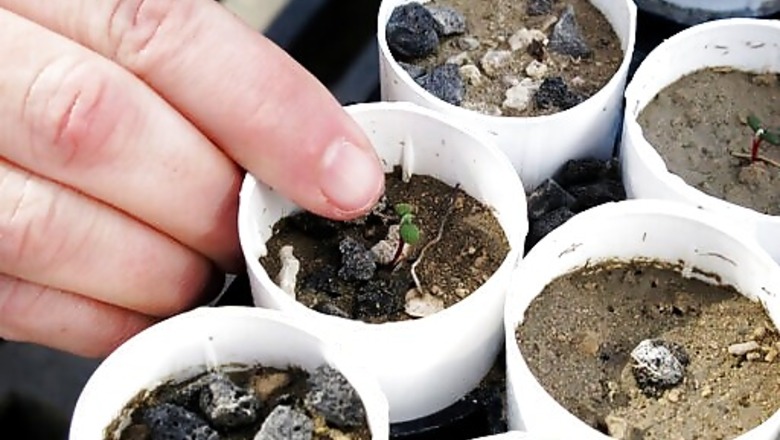
views
RENO, Nev. A botanist hired by a company planning to mine one of the most promising deposits of lithium in the world believes a rare desert wildflower at the Nevada site should be protected under the Endangered Species Act, a move that could jeopardize the project, new documents show.
The unusually candid disclosure is included in more than 500 pages of emails obtained by conservationists and reviewed by The Associated Press regarding Ioneer Ltd.s plans to dig near the only population of Tiehm’s buckwheat known to exist on earth.
Six months of communications between government scientists, Ioneers representatives and University of Nevada, Reno researchers studying the plant also show the director of UNRs work financed by Ioneer repeatedly pushed back against company pressure to prematurely publicize early success of efforts to grow buckwheat seedlings in a campus greenhouse for replanting in the wild.
Im not used to such a focus on in-progress research, Beth Leger, a biology professor who also heads UNRs Museum of Natural History, wrote in April.
I feel like maybe one very important thing isnt clear, and thats that these plants could die at any stage of this experiment.”
The experiment is part of Ioneer’s strategy intended to help avert a federal listing of the plant that could scuttle the mine.
The Center for Biological Diversity, which petitioned last year to list the plant under the Endangered Species Act, obtained the documents under a Nevada public records request. Its public information because of UNRs research contract.
The U.S. Fish and Wildlife Service recently announced its received enough scientific information to warrant a full-year review of the buckwheats status 200 miles (320 kilometers) southeast of Reno to determine whether it should be federally protected.
The emails include an April exchange with a Fish and Wildlife official who shared concerns expressed by the head of Nevadas own state listing review about Ioneers transplanting strategy.
This document is at best a mitigation plan, certainly not a `protection plan, James Morefield, supervisory botanist for Nevadas Division of Natural Heritage, wrote to the service April 16.
Ioneer has spent millions at the site rich with lithium needed to manufacture such things as batteries for Tesla’s electric cars. That includes UNR’s $60,000 grant to study transplants and $168,000 for five years of monitoring.
Ioneer President Bernard Rowe told AP in March their plans will ensure protection and, in fact, the expansion of the buckwheat population.
The emails offer a behind-the-scenes look at the sensitive relationship between public institutions and private companies funding research they often have a stake in. They indicate UNR scientists and a private one at EM Strategies Ioneer’s consultant believe the propagation efforts could benefit the plant, but dont yet prove they could ensure its survival.
Nothing we are researching is a quick fix, or even a fix. There isnt a fix for this type of impact, EM Strategies’ biology manager Kris Kuyper wrote to a UNR researcher Jan. 7.
Im sure it will be listed (it should be), then it will be a matter of consultation with the USFWS, she said.
Kuyper was responding to a UNR researcher’s concerns about providing information for a news release Ioneers PR firm wanted to issue touting the success of the plant regeneration study.
I wouldnt want them trying to frame our work in a way that would imply listing is unnecessary, or that concern for the populations that would be impacted by mining is unfounded because they may be able to be relocated, wrote the UNR researcher whose name was redacted. Even if we get encouraging initial results from the propagation and transplant efforts, we wouldnt know whether that is truly possible to establish a new population, potentially for years.”
The slow-growing flowers have fragile roots that dry out easily. As for transplants, Leger told AP then, I dont think its an awesome idea.
The emails suggest growing frustration among the researchers over what they viewed as interference with their work.
Ioneers press people reached out AGAIN, they seemingly want to publish a blow-by-blow as the research goes on, Leger wrote Kuyper in February.
When Ioneers PR firm made another media request March 4, Leger responded, Id like to wait… (for) actual results.
On March 6 she wrote Kuyper, My advice is that they just let the scientific process roll forward. … You cant count your chickens before they hatch!
Patrick Donnelly, the Center for Biological Diversity’s Nevada director, said the emails underscore the highly experimental, highly uncertain nature of the transplant strategy.
Ioneer has portrayed their mitigation as a sure-fire bet to save the buckwheat, he said. He maintains Ioneer’s current plans would wipe out the plant’s entire population and that a federal listing would mean an end to the mine.
The company said last week it is committed to being good stewards of the environment and working in lockstep with State of Nevada and Federal oversight bodies.
As such, we have retained the most reputable, independent and unbiased research team available, Ioneer said in a statement emailed to AP. This work is informing our efforts to protect Tiehms buckwheat in its natural habitat and help set a path forward to produce critical minerals necessary to reduce greenhouse gas emissions globally.
Leger said in an email Friday to AP that her job is to “present the information to decision makers, who can then make fully-informed choices about how to best protect it.
Donnelly countered:
This is science being done to greenwash a mine. … It appears that is not Dr. Legers intention, but it is very much Ioneers intention.”
___
This version corrects that the wildflower’s name is Tiehm’s buckwheat, not Theim’s buckwheat
Disclaimer: This post has been auto-published from an agency feed without any modifications to the text and has not been reviewed by an editor




















Comments
0 comment